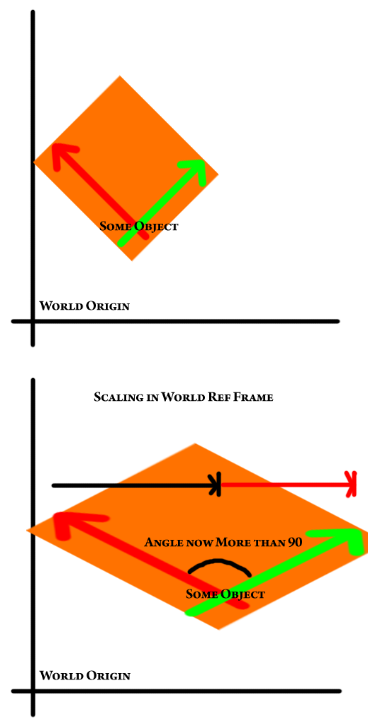A Scalable Solution Part Two: World Reference Frame
In part one of this series, I talked about scaling objects in the local reference frame and why that process is relatively simple. In this post, I will be introducing scaling in the world reference frame as well as detailing some of the differences between the two types of scaling. I will also be detailing some of the complexities as well as a possible implementation.
World reference frame scaling is somewhat more complex when compared to scaling in the local reference frame. As the name implies, this method scales an object against the world reference frame. This is not as simple as it sounds as there are some subtle complexities.
As an operation, scaling in the world reference frame is lossy if other operations such as move and rotate are performed between the scale operations. This is somewhat similar to rotating an object in 3D. In 3D rotation, rotating an object about a set of axes in some order produces a certain result where changing that order would change the final result. When scaling against the world reference frame, one needs to keep in mind that the object may rotate or scale imbetween operations while the world reference frame remains fixed. When scaling groups of objects against the world reference frame, it is also expected that the difference between their positions and the position of the centroid of the group will also scale in the same way as the objects themselves. This does not map very well to the independent transform controls typically offered by most 3D engines today; instead, we will most likely have to create and maintain our own transformation matrix, feeding that to the rendering engine on render time.
We would like to allow the user to scale an object or groups of objects in local and in world reference frames. A relatively simple way to implement this is by storing all transformations in a single transformation matrix. To retrieve the axes for scaling in local reference frame, the transformation matrix is decomposed and the rotation component is used to compute the three axial vectors. In world reference frame, decomposition is not required as the axial vectors are simply the unit vectors of the world’s reference frame ([1,0,0], [0,1,0], [0,0,1] respectively). In either case, the scale is applied by calculating a scale matrix from the axial vectors and some specified scale amount. The scale matrix is then applied to the current transform matrix thereby giving us the object’s new transformation matrix.
This implementation requires that scale and rotation be stored as a combined transform matrix. A side-effect is that scaling in the world reference frame may change rotation. I was against this idea initially as it felt like the “purity” of independent scale and rotation values is being lost, not to mention the performance hit of the frequent matrix compositions and decompositions. Having said that, I don’t think that there is another way for this to be done. Not to mention that scaling in the world reference frame against an arbitrarily rotated object is essentially a skew operation. Comments from more experienced hands on this subject would certainly be appreciated.
